

It’s been six years since the CYGNSS constellation was launched. Over that time, it has grown from a two-year mission measuring winds in major ocean storms into a mission with a broad and expanding variety of goals and objectives. They range from how ocean surface heat flux affects mesoscale convection and precipitation to how wetlands hidden under dense vegetation generate methane in the atmosphere, from how the suppression of ocean surface roughness helps track pollutant abundance in the Great Pacific Garbage Patch to how moist soil under heavy vegetation helps pinpoint locust breeding grounds in East Africa. Along with these scientific achievements, CYGNSS engineering has also demonstrated what is possible with a constellation of small, low cost satellites.

As our seventh year in orbit begins, there is both good news about the future and (possibly) bad news about the present. First the bad news. One of the eight satellites, FM06, was last contacted on 26 November 2022. Many attempts have been made since then, but without a response. There are still some last recovery commands and procedures to try, but it is possible that we have lost FM06. The other seven FMs are all healthy, functioning nominally and producing science data as usual. It is worth remembering that the spacecraft were designed for 2 years of operation on orbit and every day since then has been a welcomed gift. I am extremely grateful to the engineers and technicians at Southwest Research Institute and the University of Michigan Space Physics Research Lab who did such a great job designing and building the CYGNSS spacecraft as reliably as they did. Let’s hope the current constellation continues to operate well into the future.
And finally, the good news is the continued progress on multiple fronts with new missions that build on the CYGNSS legacy. Spire Global continues to launch new cubesats with GNSS-R capabilities of increasing complexity and sophistication. The Taiwanese space agency NSPO will be launching its TRITON GNSS-R satellite next year, and the European Space Agency will launch HydroGNSS the year after. And a new start up company, Muon Space, has licensed a next generation version of the CYGNSS instrument from U-Michigan and will launch the first of its constellation of smallsats next year.
The CYGNSS team will continue to operate its constellation, improve the quality of its science data products, and develop new products and applications for them, with the knowledge that what we develop now will continue to have a bright future with the missions yet to come. Happy Birthday, CYGNSS!

Rockets, space, and planets! These are all things the group of 40 Bangladeshi students sitting before us think of when they hear “NASA.”
“But what about the Earth?” we asked.
This past July, my colleague, Tim Mayer, and I were meeting with colleagues and collaborators in Bangladesh when we had the last minute opportunity to present NASA Earth science to a group of Bangladeshi students at the U.S. Embassy.
Amid weeks of meetings and stakeholder consultations, this felt like one of the most impactful and rewarding parts of the trip.
Dodging cars, pedal cabs, motorcycles, and scooters, we cross the street to where the red brick facade of the U.S. Embassy Annex is buffered from the bustle of the street by a line of tall bushes. We were in Bangladesh because we work for SERVIR, a joint NASA and USAID program that works with leading regional organizations to help countries worldwide use Earth observations and geospatial technologies to address environmental challenges. Tim and I work closely with the International Centre for Integrated Mountain Development (ICIMOD), a regional knowledge center based in Nepal that serves as a hub for SERVIR’s projects in several South Asian countries, including Bangladesh. Our role is to facilitate the use of NASA satellite data for applications like disaster management, weather forecasting, agriculture, and sustainable land use, but sometimes we get the opportunity to get out of the office and share Earth science with the community!
This presentation was a last minute addition to our crowded itinerary, but a welcome one. Our main purpose in Dhaka was to connect with Bangladeshi agencies, to meet and understand end user needs and catch up on project discussions after a long travel hiatus due to COVID. Through our travel planning process we got connected to USAID Bangladesh and the English Access Microscholarship Program, a program by the State Department. The program provides students aged 13 to 17 with the opportunity to learn about new topics and practice their English through invited speakers.
Entering the building, the rush of cool air provides relief from the heat and humidity of the monsoon season. We are greeted warmly by the spokesman for the U.S. Embassy as we are led into the auditorium. There’s a classroom-like vibe with the stage adorned with American and Bangladeshi flags and a State Department banner. As we set up our presentation, students begin to file in and take their seats in the rows of plastic chairs, while a buzz of excitement seems to fill the room. The spokesman introduces us to the audience and we’re off!
We ask our key question: “What do you think of when you think of NASA?” We get a flurry of answers on space and exploration, then open the door to our main point, “how about the Earth?”
As we introduce the basics of how to use satellite imagery to understand the Earth, the students are eager to answer questions with a dozen hands raised each time we pose a question. Wrapping up, we get a range of questions on scientific topics from why water boils at different temperatures at different elevations to the development of the Artemis mission. When asked about who was planning to pursue a career in science, most of the audience raised their hands!
A student asked us what event or person inspired us to pursue our current career path.
We both found our way to Earth science and remote sensing through encountering a professional who was passionate about their work. Tim got into field biology and ecology because a representative from the United States Forest Service brought an owl to his 5th grade classroom. He was fascinated by the animal and its role in the ecosystem motivated him to study the natural environment. As a lifelong outdoor enthusiast, my curiosity about the natural world around me led me to pursue an environmental career. While working as a park ranger in Yosemite I was introduced to remote sensing when I attended a presentation on the Airborne Snow Observatory, a plane that collects elevation data over snow covered peaks to predict snow volume. Learning about this technology inspired me to pivot my career path to work with geospatial information.
This question got me thinking.
Exposure to a new field that sparks your curiosity can change the course of someone’s life. Sometimes just being in the right place at the right time with someone who is passionate about what they do, can be enough fuel for your curiosity to turn into action. Career outreach helps introduce students to some of the paths available to them. After the event I had a girl invite me to speak at an environmental event she was putting on at an all women’s college. Though I was unable to attend, I was honored, and being asked made me feel like my presence and voice had made a difference.
As an engineer, scientist, mountain biker, and athlete, I have often found myself in male-dominated spaces. For me, the presence of someone who looks like me and who may communicate in a way that feels more familiar makes all the difference. It changes whether I feel comfortable asking questions, whether I feel understood and listened to, and ultimately, how much I am able to learn and engage. I will certainly take the time in future trips to meet and engage with women scientists and students.
As the presentation ended the room was buzzing with excitement, as we passed out flyers and were inundated with photo requests. We promised to connect sooner before our next trip so that they had time to organize a larger event.
If you are a scientist, or a communicator, or really anyone who is passionate about STEM I encourage you to share your passion with students. Take the time on your next trip to seek out an interested group. If you are going international connect with USAID and the local country mission. Look for English learners programs or universities or women’s groups. However you can make it happen, I assure you it is worth the effort.

In a quiet town on the border of Peru and Brazil, indigenous representatives from across the Amazon met with a team of NASA-funded geographers seeking to better understand how climate change is affecting the region–and trying to set an example for how the scientific community works with indigenous peoples.
Puerto Breu, Peru (population: 600-ish) is not the town you might think of for an important work meeting. A holdover of the late 19th Century Amazonian rubber boom, this remote outpost is only accessible by charter flights or by long, winding journeys by river boat. In June 2022, Breu hosted an important summit between SERVIR Amazonia and indigenous communities from across the southwestern Amazon. The event allowed geographers with SERVIR, a joint program of NASA and the U.S. Agency for International Development, an opportunity to listen to members of the communities they study and learn how to better protect the region from climate change and other environmental challenges.
SERVIR collaborates with leading scientific and conservation organizations in the region, such as Conservación Amazónica (ACCA) and the Upper Amazon Conservancy, which make events like this possible. The program’s mission is to address climate and environmental challenges by helping communities around the world access and learn to use data from NASA’s Earth satellites. Many of its regional projects in Amazonia are designed to aid rainforest conservation and to prioritize the participation and leadership of local communities in the process.

“Much of this region is still forested and remote, but the pace of deforestation and other illegal activities has been intensifying in recent years,” said Katie Walker, a Regional Science Associate with the SERVIR Program who helped with the event. She notes that attention on the southwestern Amazon is a relatively recent development. Scientists and conservationists have historically been preoccupied with the southeastern Amazon, where greater proximity to major cities and highways catalyzed land development.
“In the Brazilian states of Rondonia and Mato Grosso, for example, most of the land area not occupied by indigenous groups has been either deforested and converted to cropland, or has been influenced by these activities,” Walker said. “But now attention is also turning to the southwestern Amazon, where similar patterns are emerging.”
In Peru’s Ucayali Department and the neighboring Brazilian state of Acre, the Upper Amazon is threatened by climate change and demand for luxury hardwoods. Informal roads, or carreteras, built by logging and mining ventures, cut through the jungle and often serve as stepping stones for further deforestation as further human development follows. In the intense equatorial sun, losing tree cover quickly dries out the ground, which can permanently diminish the soil quality and hinder new growth. To protect the world’s climate and help preserve the region’s human and ecological heritage, scientists need in-depth understanding of ecosystem services in the region. Especially for such a historically isolated region, the scientific community needs to consult the best experts it can find: the indigenous communities who live there.
The accelerating loss of forests in the southwestern Amazon creates a major threat to the region’s many indigenous communities, like the Ashéninka, Asháninka, and Yaminahua/Jaminahua. Historically, scientists and conservationists have often prescribed answers to these communities without acknowledging the generations of knowledge these communities have regarding their surroundings.

Dr. David Salisbury, a geographer from the University of Richmond’s Amazon Borderlands Spatial Analysis Team, led the NASA-funded visit to Breu in June to meet with more than 120 indigenous representatives from communities across the Southwest Amazon. The goal of the meeting was to seek community feedback about online tools that use NASA satellite data to monitor forest conditions in the region, but also to draw connections between the observations seen in satellite imagery and the daily observations of people on the ground.
“This was a historic workshop given that we had 120 Indigenous participants from 13 different ethnicities representing a transboundary area in Brazil and Peru the size of Michigan,” said Salisbury. “Our top goal was to give our Indigenous counterparts, who are local forest and climate experts, the opportunity to see if their lived experience and long-term observations of the forests, humidity, seasonality, and rainfall matched up with forest and climate trends our University of Richmond team was picking up in our satellite imagery analysis. Once the Indigenous participants became experts in our maps, they saw the benefits of our online tools that could show how ecosystem services could change in their homelands across space and time.”
Though Salisbury has almost 20 years of experience working in this part of the Amazon (he smoothly transitions between English, Spanish, and Portuguese mid-sentence), he emphasizes that his experience is relatively little in comparison to the lived experiences of local communities. In a packed one-room schoolhouse, the team spent two days talking with indigenous communities, inviting them to introduce their communities and explain how each is seeing the manifestations of climate change on a local and personal level.
“The quantity and quality of participation was amazing […] The key was then to take the first day slowly and focus on building community through the sharing of their own expert knowledge of forest and climate,” Salisbury said. “We mapped out how they were connected to each other through culture, watersheds, and landscape as they introduced themselves. Everyone had the opportunity to get to know each other across gender, age, and geography. Once they established their expertise, built a positive learning community, and shared similar concerns for their future, we introduced the science and technology to our receptive and empowered Indigenous collaborators.”

The event used discussion groups split by ethnic group, age, and gender to better understand how the effects of climate change and deforestation are experienced in different communities and by different demographics. These groups were asked for their opinions about climate change and for their interpretations of maps the team created using data from NASA Earth satellites.
“The studies they have done will help us a lot to do our monitoring of the community, and to involve more women,” Maria Elena Paredes said. Paredes is an Ashéninka activist and the coordinator of the Community Vigilance Committee for the Sawawo Hito 40 community in Peru, and was a vocal figure in both the women’s discussion groups and in the broader conversations.
“[The studies] involve more young people so that they learn how to take care of our forest and community,” Paredes said, noting the high representation of young indigenous participants. Her son Luis was a participant in the youth-focused discussion groups.
The team hopes that feedback from the event will not only help them better tailor their data and tools to the needs of local communities, but also to set a positive example for centering the expertise and experience of indigenous communities in Earth science research. Healthy dialogue between indigenous groups and the scientific community make for conservation efforts that are more effective and socially just.
The lessons learned in Puerto Breu can hopefully improve the efficacy of applied Earth sciences, and more importantly, set a positive example for the scientific community.
We returned to Utqiagvik, the northernmost town in the U.S., for fieldwork for our project “clarifying linkages between canopy SIF and physiological function for high latitude vegetation.” We want to learn how to use the information from the light emitted by tundra plants as solar induced fluorescence (SIF) to describe the functioning of the tundra ecosystem. In the process of photosynthesis, plants not only absorb light, but they also emit light called chlorophyll fluorescence. The fluoresced light provides information about the rate of photosynthesis and about plants responses to stress. Although not much light is emitted by fluorescence, we can detect it with sensitive instruments, and even from space with instruments on satellites. We are making measurements on the ground so that we can understand how the diverse tundra vegetation is responding to environmental conditions, and how to make the best use of satellite images of this region.
This project is part of the NASA Terrestrial Ecology program’s Arctic-Boreal Vulnerability Experiment (ABoVE), a large-scale field study in Alaska and western Canada, whose overall goals are to make use of NASA technology to gain a better understanding of ecosystems at high latitudes, their responses to environmental change, and the effects of those changes.
Our field team …

In June, which is early spring for the tundra, we set up automated instruments at two existing tundra sites. Our instruments include the FLoX (Fluorescence Box), which measures the reflected light and solar induced chlorophyll fluorescence of patches of the tundra, and the monitoring PAM (MoniPAM), whose probes illuminate small patches of leaves or moss with controlled pulses of light to measure fluorescence and photosynthetic processes at the leaf level. These instruments automatically measured the fluorescence throughout the day to observe effects of varying light levels and temperatures and through the course of the growing season as the tundra plants grow. The FLoX gives us measurements of patches of ground that are like the data we can get from satellites, although measuring a very much smaller area than the satellite sees.
We returned in August to measure the tundra during its peak of summer growth.
It is a bit of a stroll out to our sites. The path has boardwalks and plastic matting laid down to protect the tundra from serious erosion from people’s feet.

Along the way there were flowers, birds, and animals to see. There were a lot of lemmings this year. When we startled these small gerbil-like animals, they would quickly run along their trails through the tundra and disappear into holes in the ground. The lemmings need to be quick because we also saw several snowy owls and a couple of arctic foxes. The owls and foxes eat the lemmings, and these predators’ populations were high because of the number of lemmings. There were also Lapland longspurs and snow buntings, sparrow sized birds that breed in the Arctic, popping around our sites.

We visited our automated sensors at the Department of Energy Next Generation Ecosystem Experiment (NGEE) Arctic flux tower site.



This image shows the three main instruments on the NGEE flux tower. On the left is an infrared gas analyzer, which measures the concentration of CO2 and water vapor in the air. On the right is an instrument to measure the methane concentration. In the center is a sonic anemometer. The sonic anemometer very accurately and rapidly measures the upward and downward wind speed. The vertical wind speed information combined with the measurements of CO2, water vapor, and methane concentrations from the other sensors can be used to calculate their transport into and out of the ecosystem. For example, CO2 taken up by the ecosystem is a measure of the rate of photosynthesis.
We visited our sites to check on our automated sensors to make sure they are running and collecting and storing data.



While at the sites, we also make additional measurements to add to the data from the automated sensors.


Our second site was at the National Science Foundation’s National Ecological Observatory Network (NEON) flux tower.
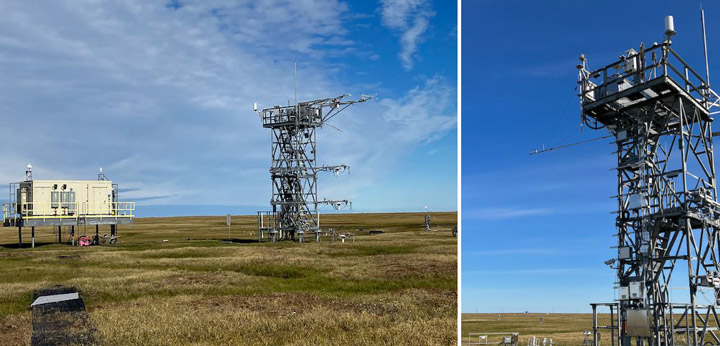

We also measured a number of plots with different types of vegetation cover within this area of high-centered polygon tundra near the lab building.

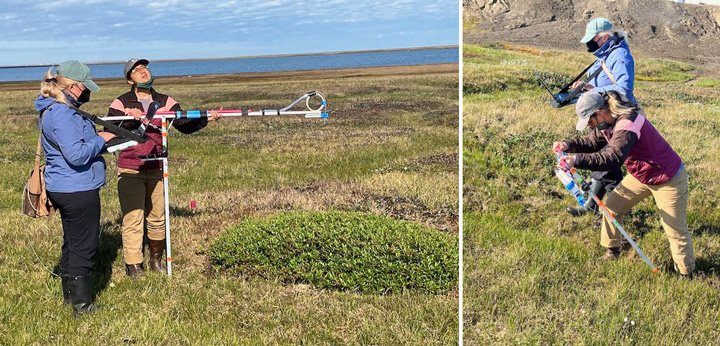
When the weather turned bad (rainy and in the 30s Fahrenheit) we worked in the lab measuring photosynthesis, fluorescence spectra, and chlorophyll content for plant samples from our study plots.

As a side project we located the transect I worked on 20 years ago and remeasured it. Even after all of these years I was surprised that I didn’t have any problem finding the start of the transect, and there was still a wooden stake there. But we couldn’t locate a marker for the far end, so we had to use GPS to locate it. It pleased me to see that the path we had worn by walking on the tundra 20 years ago had healed and I couldn’t see any sign of it now.
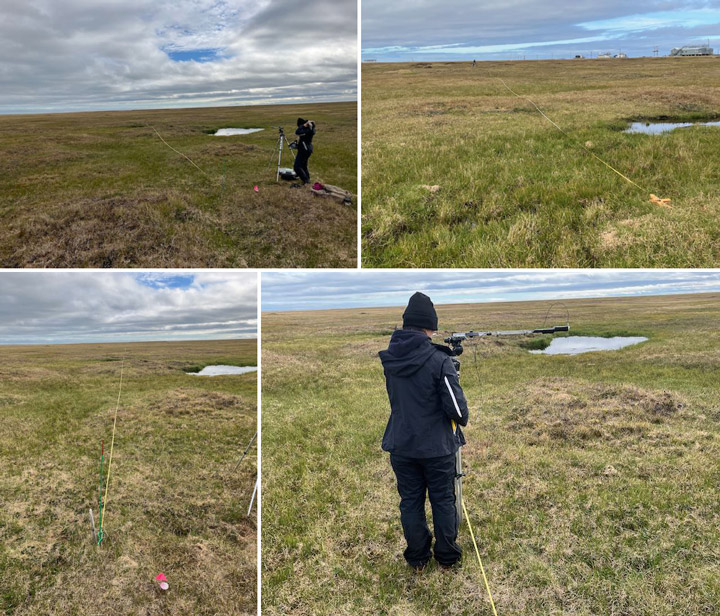
Another day we visited the International Tundra Experiment (ITEX) site. The site was established back in the 1990s for the long-term monitoring of plant growth.
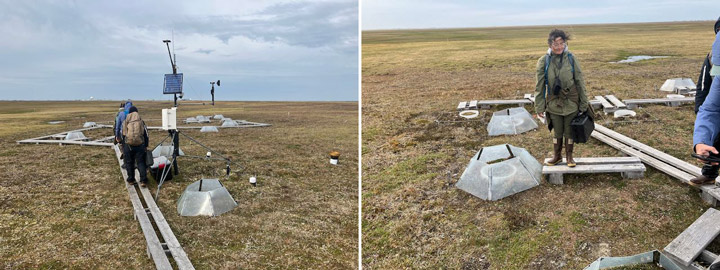
Regular measurements of reflectance, soil moisture, water table height, and the depth of permafrost thaw (using the high-tech method of pushing a rod into the ground until it hits the frozen layer) are made throughout the growing season.
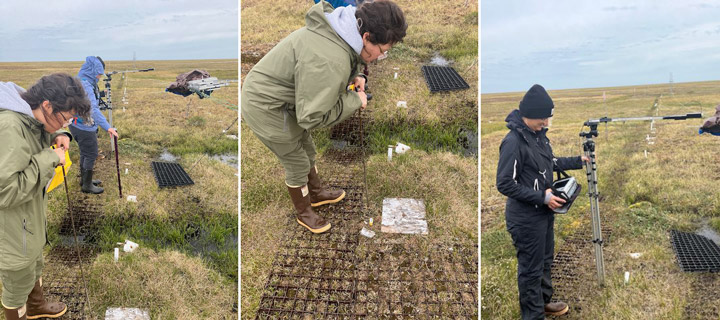
At the end of our field campaign, we removed all of our equipment from the field.
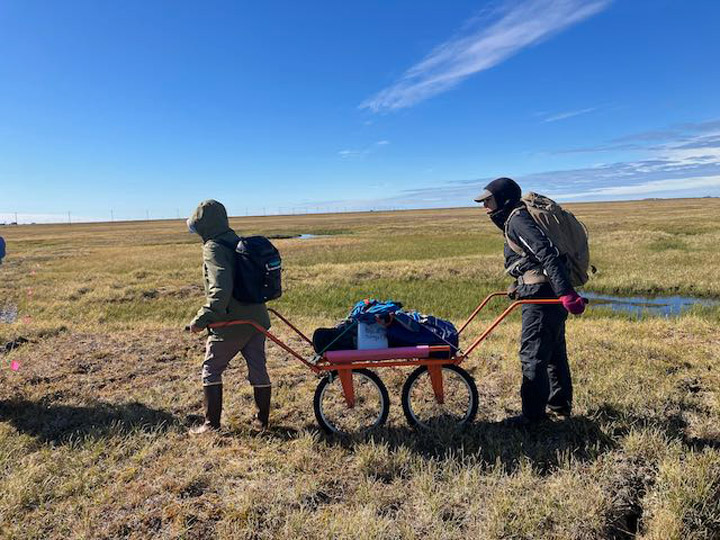
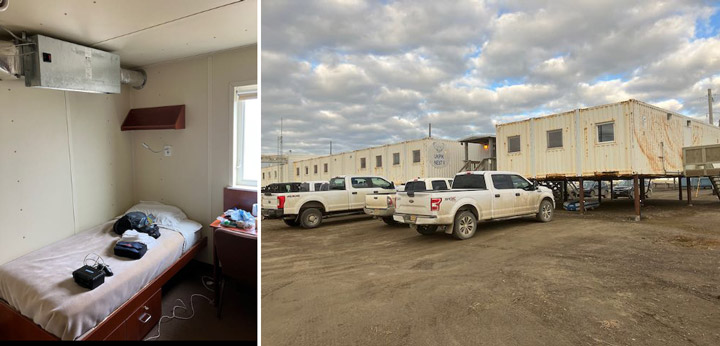
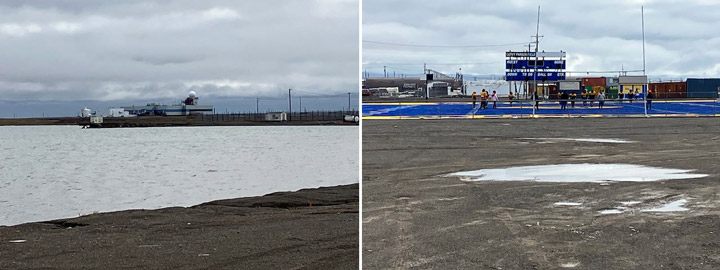
We live and work outside of Utqiagvik on the grounds of the former Naval Arctic Research Lab (NARL). NARL was founded 75 years ago, during the height of the Cold War. NARL was part of a tradition of research in Utqiagvik. The facility is now managed by the Ukpeaġvik Iñupiat Corporation (UIC), the native-owned corporation that manages the Barrow Arctic Research Center (BASC). Some of the buildings left behind by NARL are now used by BASC and Ilisagvik College, the only tribally controlled college in Alaska and the northernmost accredited community college in the U.S.


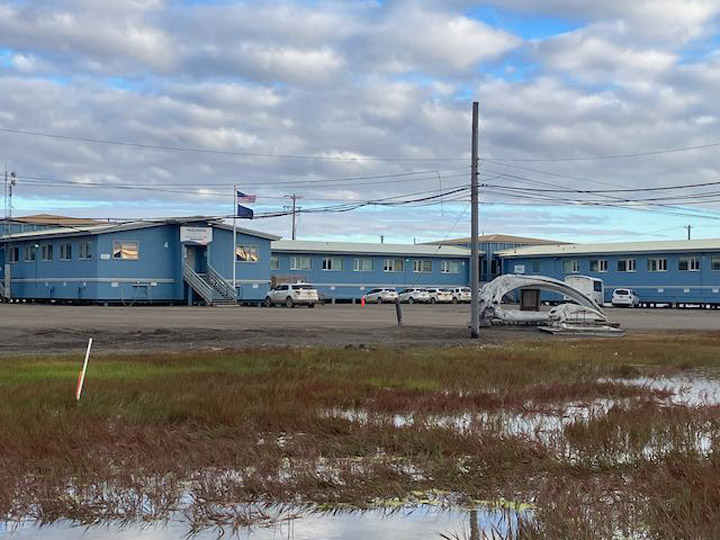
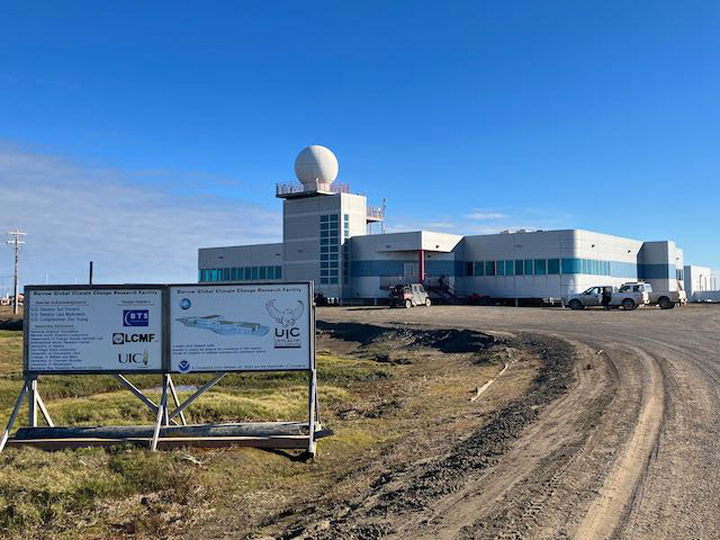

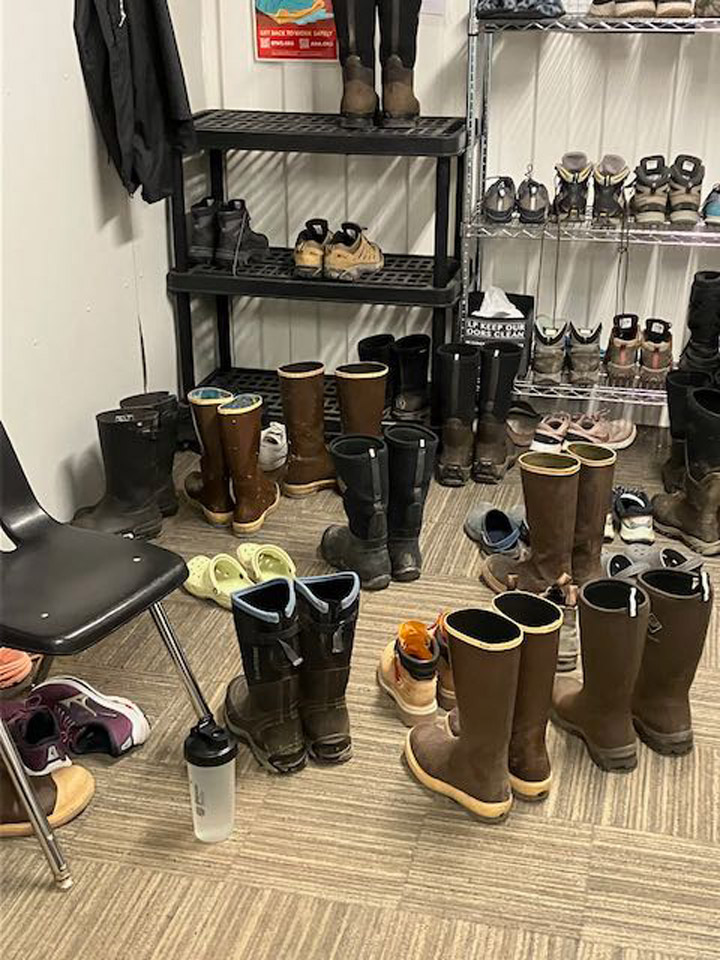
There are no roads to Utqiagvik. Almost everything has to come in by air.
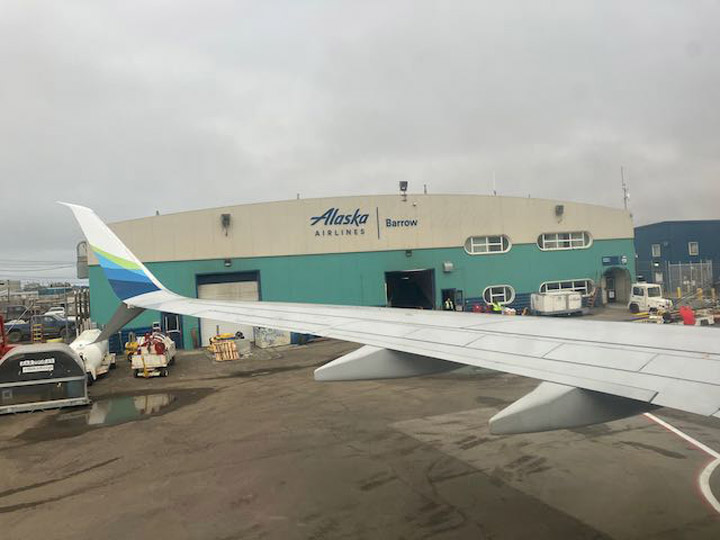
Heavy or bulky stuff that is not shipped by air freight comes up once a year on a barge.

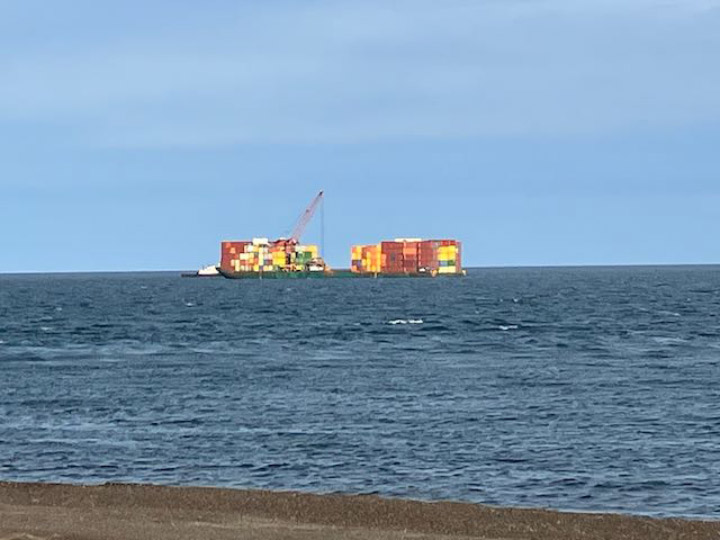
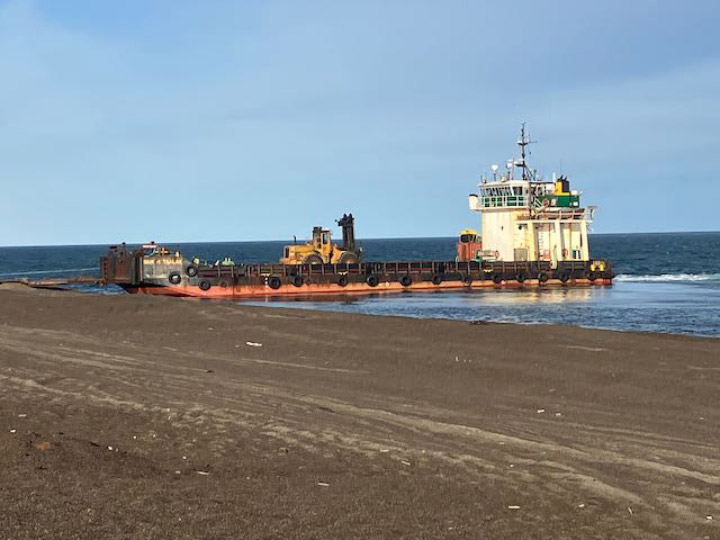
The annual barge arrived while we were up there. There’s no dock to unload on (the sea ice would probably destroy one) so they use a landing craft to bring the stuff ashore.
The most exciting animal sighting was on my last day when we saw several Beluga whales swimming near shore near the place where they had been bringing the cargo from the barge ashore.
In a lot of ways Utqiagvik is like any other town.
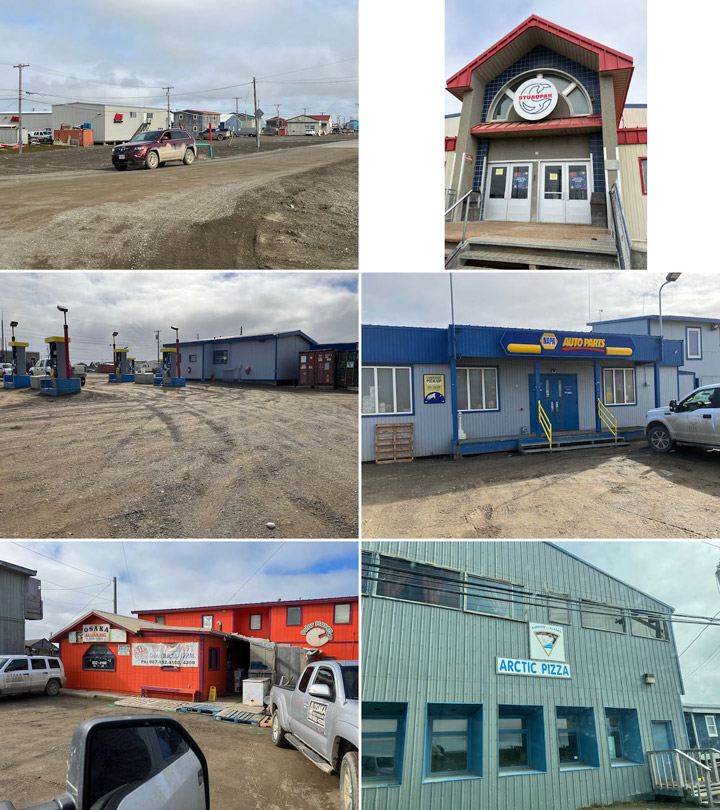
There’s a modern supermarket, the Stuaqpak (which means “big store” in Iñupiaq), a hardware store, pizza places, Chinese restaurant, and gas station. But then there are twists. All the streets are gravel, except for the one street that runs in front of the airport. The auto parts store also sells whaling equipment. Gas comes up on the barge once a year, so the price of gas stays the same until they start tapping the new shipment. When the restaurant is open, you can look out on the Arctic Ocean while you have a slice at Arctic Pizza.
Also in town is the Iñupiat Heritage Center, which has exhibits on the people and their culture.
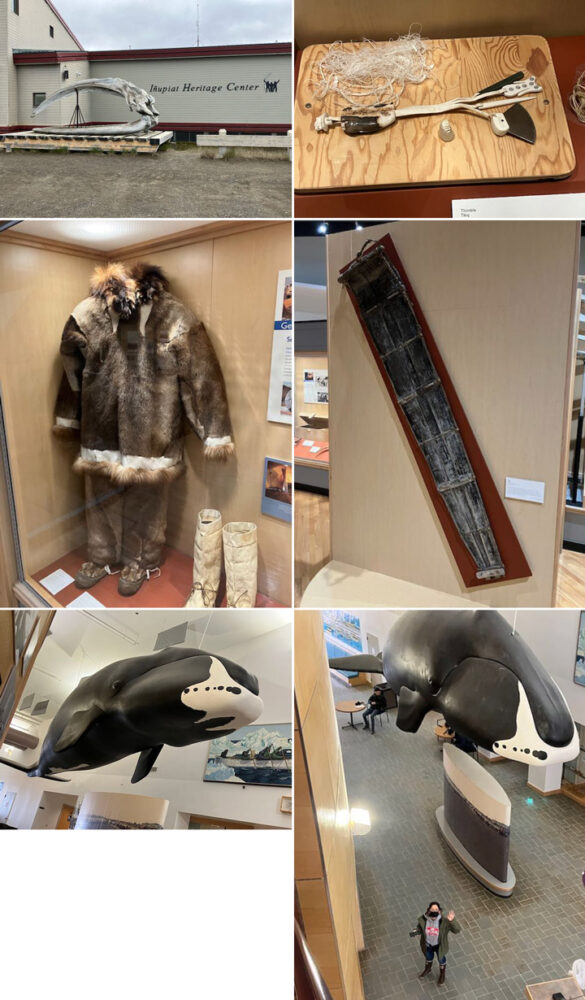
In front of the building is a bowhead whale skull about the size of a VW Beetle. There is a picture of a field sewing kit and sinew used for thread (upper-right). One thing I learned at the center is the critical importance of sewing for survival in the Arctic. The quality and maintenance of clothes is a matter of life and death in this harsh climate (middle-left picture). The ability to sew is also important for making the coverings for skin boats, which are used to hunt whales and other sea life. The middle right picture is a sled made out of the baleen from the whales. In the lobby is a life-sized model of a young bowhead whale (lower pictures). You can get a sense of its size compared to Brenda.
On a warm July morning an Unmanned Aerial Vehicle (UAV) quadcopter rises up through a gap in the tall, dense deciduous forest canopy at the Smithsonian Environmental Research Center (SERC) in Edgewater, Maryland. Hanging down from the quadcopter is a pole with a black robot claw at the end (video, above). Under the control of students Emmy Braun and Charlie Southwick of West Virginia University, the quadcopter flies above the forest canopy to a specific tree where it carefully drops down and grabs a branch with the claw. The claw cuts off a branch sample from the tree top and carries it down to the ground, where the researchers await, ready to take it to the lab for measurements (Figures 2 and 3).


Our project, “Quantifying leaf-to-landscape predictors of tropical forest drought vulnerability through ISS observation-model integration,” led by Dr. Loren Albert of WVU aims to use measurements from these branch samples to better understand how to use data from the International Space Station (ISS) to detect the effects of climate variability on tropical forests.
We regularly see astronauts floating around in the ISS, working on experiments inside or doing space walks outside the station, but what does the ISS have to do with tropical forests? The ISS has become an important platform for state-of-the-art Earth observing instruments. Among the instruments on ISS there are four that can describe key characteristics of forests. These instruments include the Global Ecosystem Dynamics Investigation (GEDI) which uses lasers to determine the height and structure of forests; the DLR Earth Sensing Imaging Spectrometer (DESIS) that breaks up the light reflected from plants into hundreds of narrow color bands that can be used to describe the biochemistry of leaves; the Orbiting Carbon Observatory-3 (OCO-3) that measures the amount of carbon dioxide in the atmosphere and also can describe the light emitted by plants as part of photosynthesis which can be related to plant productivity; and the ECOsystem Spaceborne Thermal Radiometer Experiment on Space Station (ECOSTRESS) which measures the temperature of plant canopies and can detect the occurrence of water stress in plants. Together, this suite of instruments has the potential to significantly improve our understanding of how plants function and respond to stress.
The goal of the SERC campaign was for team members from WVU, the University of Maryland Baltimore County, NASA Goddard Space Flight Center, and the Smithsonian Institution to work together to develop and refine protocols for data collection for future campaigns in tropical forest sites. SERC is home to one of the Forest Global Earth Observatory (ForestGEO) sites. ForestGEO is a global network of sites that monitor tree growth and death, biodiversity, and function for a wide range of forest types. The ForestGEO site at SERC is a deciduous forest dominated by tulip poplars that are over 100 feet tall and over 100 years old, where every stem larger than 1 centimeter in diameter is identified and mapped (Figures 4 and 5). After working at SERC the team will take what we’ve learned and move on to the ForestGEO site in Panama on Barro Colorado island for a field campaign in the fall of 2022.


A persistent challenge in trying to study trees in tall forests is getting access to sunlit canopy leaves—the leaves observable by remote sensing instruments viewing the trees from above. This is where the robot claw on the quadcopter comes in. Leaves from the samples returned by the quadcopter for the major tree species were measured to determine their photosynthetic light response, their chlorophyll content, spectral reflectance, and chlorophyll fluorescence (Figures 2 and 6). These data will be used to parameterize the SCOPE vegetation biophysical and radiative transfer model to connect with remotely sensed data from ISS instruments.
